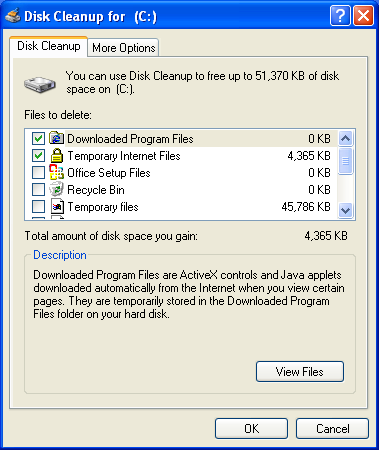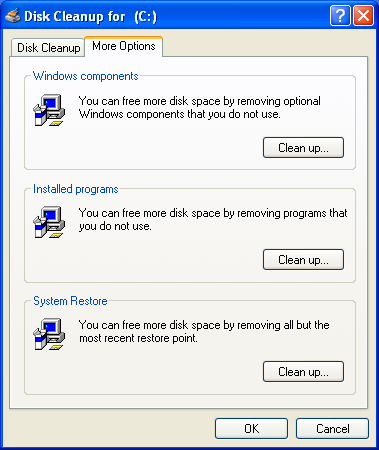| Nos esforzamos para localizar nuestro sitio web en tantos idiomas como sea posible, sin embargo, esta página no está traducida máquina usando Google Translate. | cerca |
-
-
productos
-
recursos
-
soporte
-
empresa
-
¿Cómo liberar espacio en mi disco duro?How Do I Free up Space on My Hard Drive?
Por Mark Beare Mayo 10, 2010computer cleaning, computer performance, optimization, slow pc, windows registryNo hay comentarios
Aunque el espacio en el disco duro es más barato de lo que ha sido en este momento, nunca parece ser suficiente para albergar nuestras colecciones de música, películas, imágenes y programas en constante expansión.
Ayuda, necesito liberar espacio en mi disco duro.
Pensamos que nos tomaríamos el tiempo para mostrarle algunas de las formas en que puede liberar espacio extra en el disco duro sin tener que invertir en una conducción más grande o eliminar sus archivos personales.
1. Usando la herramienta Disk Cleanup
Windows ofrece una herramienta de sistema llamada Liberador de espacio en disco que le permite eliminar archivos innecesarios de sus unidades de forma regular. Estos incluyen archivos temporales, archivos sin conexión y archivos antiguos que no se están utilizando.
Así es cómo:
Inicio> Programas> Accesorios> Herramientas del sistema> Liberador de espacio en disco> Seleccionar unidad
Después de realizar el escaneo, debería ver la siguiente ventana:

En la ventana de arriba se muestran los tipos de archivos que puede elegir eliminar y la cantidad de espacio libre que obtiene. Seleccionar cada archivo proporciona una descripción adecuada de los tipos de archivos. Así que simplemente seleccione todo lo que no necesita y haga clic en Aceptar. Eso debería completar la limpieza y liberar la cantidad de espacio especificada.
En Más opciones, tiene tres opciones específicas para elegir, como se muestra a continuación:

Básicamente, lo ayudan a eliminar los componentes de Windows, los programas instalados y limpiar el espacio utilizado por la función Restaurar sistema (no recomendado a menos que sea necesario). Tenga en cuenta que también tiene una opción para desactivar por completo la función Restaurar sistema.
Entonces, usando la herramienta anterior, puede liberar espacio equivalente a la cantidad de archivos innecesarios y aplicaciones que pueda tener en su disco duro.
2. Desinstalar programas antiguos / no utilizados de tu PC
Esta opción está disponible en el método anterior y también se puede usar de otra forma, usando la herramienta Agregar o quitar programas en el Panel de control. En general, se recomienda que elimine el software que no está utilizando o que no tiene la intención de usar en el futuro cercano. La eliminación de programas de software que no utilice puede liberar mucho espacio según el programa y también puede tener un impacto notable en el rendimiento de la computadora. Solo recuerde que después de desinstalar o instalar el software debe ejecutar un escaneo de registro de Windows .
3. Deshabilitar el modo ‘Hibernación’
Si no usa la función de Hibernación en su PC y prefiere apagarla, la desactivación del modo de Hibernación ayuda a liberar una cantidad considerable de espacio en disco. Cuando el modo de hibernación está habilitado, debe recordar todo el estado de su computadora cuando entra en hibernación, lo que consume mucho espacio en el disco duro. La configuración para esto se puede encontrar en el área Configuración de energía del Panel de control de Windows.
4. Eliminación manual de los archivos necesarios para desinstalar las actualizaciones de Windows
Esto solo es aplicable para Windows 2000 y XP.
Así es cómo:
Establecer la configuración de la carpeta para ver los archivos ocultos
Ahora ve a Mi PC> C: Unidad> Windows o carpeta Winnt y deberías ver las carpetas $ NTUninstall .
Simplemente elimine los archivos $ NTUninstall y las carpetas que tienen más de un mes de antigüedad y debería notar un incremento en su espacio libre.
Así que ahí lo tienes, cuatro formas fáciles de despejar espacio en tu disco duro y no tener que considerar borrar tus archivos personales. ¡Esperamos que les sirva de algo!
El equipo ReviverSoft
Was this post helpful?YesNoGratis Actualizaciones de controladores
Actualiza tus drivers en menos de 2 minutos para disfrutar mejor rendimiento de la computadora - Gratis.
Gratis Actualizaciones de controladores
Actualiza tus drivers en menos de 2 minutos para disfrutar mejor
rendimiento de la computadora - Gratis.
¿No ha encontrado la respuesta?Haz una pregunta a nuestra comunidad de expertos de todo el mundo y recibir una respuesta en ningún momento a todos.most relevant artículos recientes Copyright © 2025 Corel Corporation. Todos los derechos reservados. Términos de Uso | Privacidad | CookiesFijarlo en Pinterest